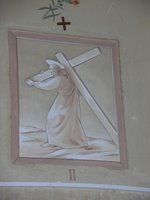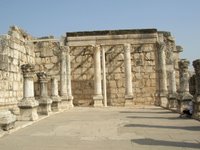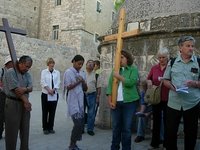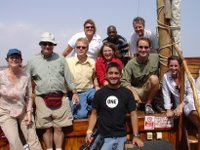The Vision of Nehemiah
In his introductory notes to the book of Nehemiah, David Charles Mainse wrote, "Nehemiah's prayer and fasting, qualities of leadership, powerful eloquence, inspirational organizational skills, confidence in God's purpose, and quick, decisive response to problems qualify him as a great leader and man of God."
Nehemiah is one of my heroes of the Bible. I love this book. We could camp out here for a whole year on Thursday Leadership Lesson to unpack leadership principles from this book. And we could initiate a whole new series exploring Nehemiah's visionary leadership. We certainly cannot capture all of the important things from this book in one day or in one article. So I encourage you to read and meditate on this book yourself. For today, let's pull out a few key examples.
The Vision Begins
It all began with a conversation of divine destiny in Nehemiah 1:1-3: "In late autumn of the twentieth year of King Artaxerxes reign, I was at the fortress of Susa. Hanani, one of my brothers, came to visit me with some other men who had just arrived from Judah. I asked them about the Jews who had survived the captivity and about how things were going in Jerusalem. They said to me, 'Things are not going well for those who returned to the province of Judah. They are in great trouble and disgrace. The wall of Jerusalem has been torn down, and the gates have been burned.'"
When Nehemiah heard this, the trajectory of his life changed. This message catalyzed a career move. It was the first step from being a good leader (as cupbearer to the king, he was a trusted companion and advisor) to a visionary leader.
In discussing the principles of passionate vision on Thursday Leadership Lesson, we talked about principles of receiving a vision and doing the hard work of personal preparation. We have talked about how to go public with the vision. And we have talked about how to execute the vision. Let's look at how Nehemiah approached each of these.
Personal Preparation
Nehemiah's vision began when he heard the news of Jerusalem. I think it's significant that Nehemiah learned this news because he asked a question. Although Nehemiah served comfortably in the King's palace, his heart remained in Jerusalem, and the vision that God gave to him was tied to the passions of his heart. God has given each of us unique gifts, passions, and opportunities. Asking questions that are tied to the passions of our heart can lead to vision. A leader should always be learning about the issues that are meaninful to him.
Immediately, Nehemiah "sat down and wept." In fact, for days he "mourned, fasted and prayed to the God of heaven." He confessed his sins, his family's sins, and the sins of Israel. He recalled history and prayerfully considered the ways God had worked in Israel's past (Nehemiah 1:4-10). Nehemiah's vision was birthed and bathed in prayer.
Nehemiah was willing to wait on God's timing. He received the news of the wall in the Hebrew month of Kislev, which was in the late fall and most likely November or December. He did not leave for Jerusalem until the Hebrew month of Nisan, or April. He waited patiently and prayerfully for 4-5 months until the time was right. Sometimes, the hardest part of vision is the waiting.
To pursue his vision, Nehemiah was eventually required to leave his position in the court of King Artaxerxes to relocate to Jerusalem. To pursue his vision, he was required to leave what the security of what was known. He had to say "no" to one thing in order to say "yes" to something else.
Three days after Nehemiah arrived in Jerusalem, he went out to survey the wall. At that point, he "had not told anyone about the plans God had put in my heart for Jerusalem" (Nehemiah 2:12). Nehemiah did not communicate his vision or go public until he gathered the facts, received direction from God, and formulated a plan. In Nehemiah 2:16, he said, "The city officials did not know I had been out there or what I was doing, for I had not yet said anything to anyone about my plans. I had not yet spoken to the religious and political leaders, the officials, or anyone else in the administration." Nehemiah moved slowly and wisely through the hard work of hearing from God and personally preparing for the vision before going public.
Personal preparation often begins years before a vision is revealed. Nehemiah obviously worked well for many years as the cupbearer. As cupbearer, he was trusted by the king. And when it was time to go public, his relationship with the king paid huge dividends. Good leaders will focus on developing Godly character.
Going Public
There were several stages of "going public" for Nehemiah. First, he had to go public with his boss, King Artaxerxes. In Nehemiah 2, when he had to make "the big ask"-- he had to sell his vision and get the king to buy into it. The king granted him permission to return to Jerusalem to rebuild the wall. But the king did not simply grant Nehemiah permission to go build the wall. He invested in the vision personally by giving Nehemiah an armed escort on the journey and timber for the construction project.
When communicating a vision, make sure to communicate it confidently yet respectfully to those who are in positions of authority in your life. They can give you guidance and accountability. If you have done the hard work of personal preparation, then it is likely they will not simply grant permission but also find ways to invest in you as a leader.
Nehemiah was required to go public a second time once he arrived in Jerusalem. As we read earlier, he initially did not tell any of the city officials, religous leaders, or political leaders what he was doing. But after he inspected the walls, he went public with the vision in Nehemiah 2:16-18. He said, "But now I said to them, 'You know full well the tragedy of our city. It lies in ruins, and its gates are burned. Let us rebuild the wall of Jerusalem and rid ourselves of this disgrace." When Nehemiah communicated, he gave a colorful illustration of the current status and a compelling picture of a possible future. He showed what was wrong with the wall- it was a tragedy and a disgrace. He told them about the "gracious hand of God" and how the vision fit into their calling as a people.
Executing the Vision
To execute his plan, Nehemiah developed a plan, harnessed the power of partnerships, responded to critics well, met the needs of his team, and kept the vision at the forefront.
Planning
Chapter three of Nehemiah is interesting. It is one of those chapters, like those in the book of Numbers, that we are tempted to simply skim because it appears to be only a listing of names and places. But chapter three is actually Nehemiah's strategy for executing his vision. It contains his plan and his partnerships. He broke the big vision down into smaller manageable and quanitifiable step by dividing the wall into sections. He enlisted and deployed approximately 40 groups of people to work at different places along the wall. They each had a specific job to do to make the bigger vision a reality. These were S.M.A.R.T. goals (see Executing the Vision).
Partnerships
Nehemiah understood the importance of harnessing the power of relationships. He had already learned the power of relationships through the investment that his former boss made in the project. In Jerusalem, he partnered with 40 groups of people to do the physical work of the vision. But he also partnered with Ezra and possibly Malachi to get their help in communicating the vision. Ezra worked with Nehemiah to orient the entire vision execution around the ways of God and to point people to God and his Law (Nehemiah 8). Ezra helped Nehemiah in the teaching, establishment, and enforcement of God's law.
Critics
Whenever you pursue vision, people will criticize you. Rick Warren said, "When you're small, they'll dismiss you; when you're growing, they'll criticize you; and when you're large, they'll resent you. So ignore 'them' and get on with whatever God has told you to do!" Nehemiah was plagued by the criticism of the three stooges- Sanballat, Tobiah, and Geshem. Sanballat, whose name means "Sin gives life, " was the ringleader of this crew. One piece of leadership advice: Never listen to a person whose name means "Sin gives life."
How did Nehemiah respond to the three stooges? He prayed (Nehemiah 4:9), he encouraged the people on his team not to be discouraged (Nehemiah 4:14), he gave people additional resources and a plan so they could focus on getting the work done (Nehemiah 4:16-18), and he narrowed his focus to the goal and worked so hard that he never even changed his clothes (Nehemiah 4:21-23).
If you are pursuing God-ordained vision, people will criticize you and they will misunderstand and misrepresent you. In chapter 6 of Nehemiah, the critics started spreading rumors-- we hear you plan to rebel, you plan to make yourself king, you appointed prophets to prophesy about how great you are. They sent him a letter threatening him that he had better "come and talk it over" with them. On five different occasions, the critics asked Nehemiah to come talk with them. Nehemiah simply responded, "I am doing a great work. I cannot stop to come and meet with you" (Nehemiah 6:3)
As a general rule, follow Nehemiah's lead. Ignore the critics. But let me bring some balance. Scripture does teach us that there is wisdom in the multitude of counsel. We must keep soft and humble hearts before God and place ourselves in accountable relationships with Godly people. In general, criticism that is most constructive will come from those who love you but love God more. Many times, criticism comes from folks that don't know you and don't love you. Pastor Mark has a good rule of thumb regarding how we should respond to criticism: Do not allow an arrow of criticism to pierce your heart unless it first passes through the truth of Scripture. In Nehemiah 2:20, Nehemiah tells his critics, "You have not stake or claim in Jerusalem." Listen only to critics who speak Biblically and have a personal stake or a claim in the vision.
In Nehemiah 4:9, we read Nehemiah's most basic plan for executing his vision: "But we prayed to our God and guarded the city day and night to protect ourselves." In short, he prayed like it depended on God and worked like it depended on him.
Team Training
Nehemiah met the needs of his team while staying focused on the vision. In Chapter 6, we read of struggles with famine and oppression. Like every leader, Nehemiah found himself navigating problems with his team. He appreciated them, valued them, and worked to implement Godly rules and to create a fair working environment. But he always kept the vision of rebuilding the wall front and center. It is easy to spend all of our time managing the urgent issues and responding to the crises. Leading a team requires lots of time, compassion, and patience. But your vision will never come to pass if your team is not cared for well. Address the issues, but never lose sight of the vision. Keep one hand extended to the team, but keep one hand in the workd of the vision and always keep your eyes squarely focused on the vision.
The wall of Jerusalem was completed in 52 days.
Finishing Well
One final note. After the wall was rebuilt and the people of Jerusalem were reconnected with God, Nehemiah returned to his position in King Artaxerxes' court (Nehemiah 13:6). When he returned to Jerusalem later, he realized some vision decay and drift had occured. That old goon Tobiah had even weasled his way into a room in the Temple and taken up residence. Nehemiah had to clean house and re-orient the people around the ways of God. The hard work of vision is never done. The critics never go away. You have to keep communicating, keep leading yourself well, and keep pointing people to God.










 Sacred Roads: Exploring the Historic Paths of Discipleship
Sacred Roads: Exploring the Historic Paths of Discipleship
